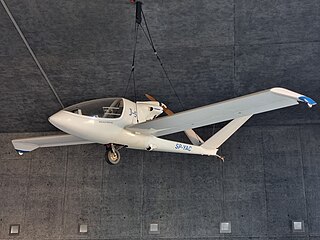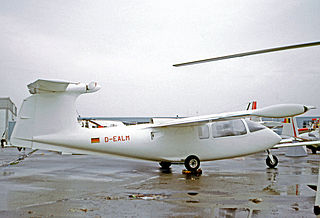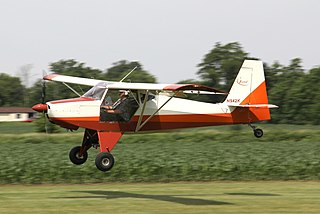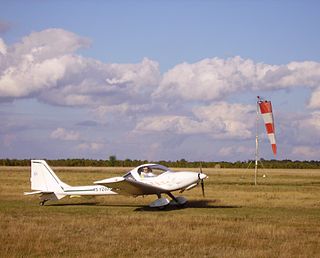
The Grob GF 200 was a business aircraft of unorthodox design developed in Germany during the 1990s.

The Remos G3 Mirage and Remos GX are German high wing, two seat, single engine light aircraft, built by Remos AG of Pasewalk. The aircraft is supplied as a kit for amateur construction or complete and ready-to-fly.

The AISA I-115 is a low-wing single-engined military primary trainer with tandem seating, which went into service with the Spanish Air Force in 1956. After retirement in 1976 many were sold to civil operators.

The Dyn'Aéro CR.100 is a French kit built single engine, two-seat monoplane, developed in the 1990s and intended as both an aerobatic trainer and a tourer, primarily for aero club use.

The Alpha J-5 Marco is a single-seat airplane in pod-and-boom pusher configuration. Kits were built in Poland and the aircraft has been exported to several countries including Germany and the USA.

The Dream Tundra is a robust, single-engine, high-wing monoplane designed in Canada. Seating four, its short takeoff and landing characteristics can be adapted to land, snow, or water use. It is produced as a kit for homebuilding.

The B&F Fk9, also marketed as the FK-Lightplanes FK9, is a German-designed single-engine, two-seat ultralight, first flown in 1989. It has been developed from a mixed structure, fabric covered aircraft to a wholly composite machine. It remains in production at factories in Germany and Poland and has sold in large numbers, flying on four continents.
The Iannotta I-66L San Francesco is a 1960s Italian ultralight designed to be homebuilt from plans. It has been powered by several flat-four engines in the 65-100 hp range and built in both single and two-seat tandem configurations. Only small numbers have been completed.

The Ameur Altania was a single-engine light aircraft of pusher configuration with side-by-side seats for two and a V-tail, designed in France in the 1990s. Several prototypes were built and flown, including a 15 m span motorglider version; the final prototype was constructed from carbon composites rather than glass fibre. Another version, the UCA Carbon Bird has been built by Universal Composite Aviation after the bankruptcy of Ameur Aviation.

The Pöschel Equator was a single engine, 6/8 seat amphibious aircraft built in the 1970s featuring glass-fibre covered fuselage. Three aircraft were built, each with different engine or wing positions, but no production followed.

The EDRA Aeronautica Super Pétrel is an amphibious pusher configuration biplane, seating two side-by-side, brought into production in Brazil in 2002 though with French parentage. It remained in production in 2011, in kit and flyaway forms.
The IAE VUT Marabou was built as a piloted test vehicle to develop autonomous control of unmanned aerial vehicles (UAVs) flying in civil airspace. Czech-designed and constructed, it first flew in April 2010.
The Lambert Mission 212 is a conventionally laid out low-wing, fixed undercarriage, single-engine, four-seat kit built aircraft designed in the UK by a Belgian college student. Kits are manufactured in Belgium.
The Tisserand Hydroplum is a small amphibious aircraft with a single, pusher engine, built in France in the 1980s. Originally a single-seat, high-wing monoplane, it was developed into a two-seat biplane for production in kit form as the SMAN Pétrel.

The Just Escapade is a single-engine, high-wing light aircraft, seating two in side-by-side configuration. It was jointly developed in the United States and the United Kingdom in the early 2000s and by 2010 some 145 Escapades and its "bush plane" variant, the Highlander, had been built and many more kits sold.

The Aviamilano F.14 Nibbio is a four-seat, single engine cabin monoplane built in Italy in the late 1950s. Only ten production aircraft were completed.

The Ellison-Mahon Gweduck or Geoduck is an American twin-engine amphibious aircraft, built from composites to resemble the Grumman Widgeon.

The Aviakit Véga is an ultralight aircraft seating two in side-by-side configuration. It was designed in France in the late 1990s to be easily constructed by amateurs from kits and was offered with a choice of three engines and of tricycle or conventional undercarriages.
The Stephens Akro is a single engine monoplane designed in the United States for aerobatic competitions. It first flew in 1967 and proved very successful, leading to several developments of which one won seven US Championships and one World Championship between 1975 and 1982. The Extra EA-230 and Extra EA-300 were also Akro developments with over two hundred built.
The Aerodis AA200 Orion is a four-seat prototype light aircraft designed in the United States and which first flew on April 7, 1991. Aerodis commissioned the design with the intention of developing a family of related aircraft sharing a common basic airframe, including the AA300 Rigel and AA330 Theta. Aerodis was also the American distributor for the Grinvalds Orion, a French light aircraft intended for homebuilding. Although the Aerodis Orion and Grinvalds Orion shared a same basic configuration and composite construction, the two aircraft were not further related, and the AA200 was an all-new design. The designs are sometimes known as the CRSS AA200 Orion, CRSS AA300 Rigel, and CRSS AA330 Theta after the rights to the designs were sold to Indonesian manufacturer CRSS.















